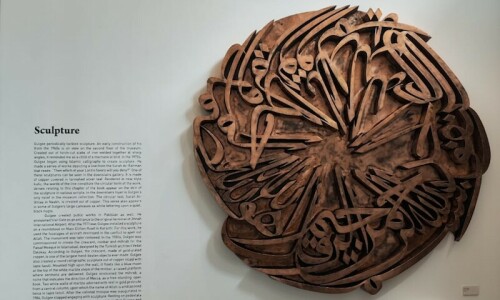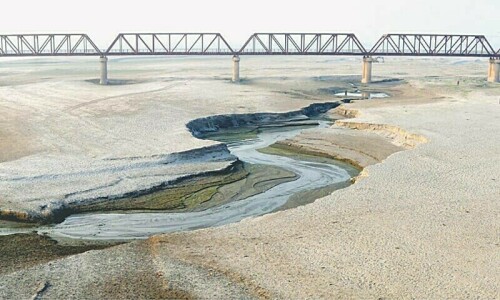Sitting on a carved chair at a hotel in Skardu, Mohammad Amin was talking to tourists who had arrived there late in the afternoon and were enjoying their cups of coffee. Amin, a local retired schoolteacher, is famous among visitors to Skardu for his intimate and deep knowledge of Gilgit-Baltistan.
It was through Amin that I had learnt about Little Karim, the famous porter of the Baltistan valley who has scaled all the 8,000-metre peaks in Pakistan without an oxygen mask. Sadly, Little Karim received little attention for this feat as many Western mountaineers tend to get for their accomplishments.
I had been travelling to Gilgit-Baltistan since 2007 but it was through 76-year-old Amin that I found out about some ‘hidden’ historical sites in Chunda Valley. For example, a tale that according to him, is known to every villager in the valley and was narrated to him by his grandfather. A few Swiss and Italian climbers also joined us to hear Amin’s story.
A local myth spurs a search for historical sites in Gilgit-Baltistan
“My grandfather told us many years ago that a devastating flood had drowned all of Skardu, Shigar and Khaplu valleys; people could not find any place to hide except in the mountaintops of Chunda,” he said. “The entire valley was filled with floodwater and people used boats to travel to and fro. The remnants of the harbour and anchor can still be seen today.”

“One can find big shelters built naturally on the top of the mountain. You can see strange carved stones in dinosaur-like shapes,” he added. “You will find desert-like area along the riverbed in all of Skardu till Shigar, and even at the Skardu airport, which proves that many years ago Skardu was flooded.”
I was a tad sceptical of Amin’s story — during my travels through all of Gilgit-Baltistan, especially Skardu, I had never heard any of such area. But it seemed that Amin was aware of every nook and hidden corner of the valley. And when his story was also repeated by my friend Ghulam Nabi, I was intrigued.
An official in the federal government, Nabi was born in Chunda Valley but he and his family moved to Karachi 40 years ago. My friend most likely heard the story from someone in his family.

Harsh weather made it impossible to explore the valley on that particular trip but I was determined to find the mysterious harbour in Chunda Valley and on my next visit to Skardu.
The track was very rocky, dotted with trees of every hue. It was a tough hike but its beauty more than made up for it. After about 20 minutes, we reached the top of Chunda Mountain, one of the highest mountains in Skardu valley. From the peak we could see far and wide. I can bet there is no place in all of Skardu which can provide such a stunning bird’s-eye view of the valley.
In search of Chunda
On a sunny and cloudless Sunday, my friends Nabi, Zahid Hussain and I started our journey from Skardu airport and took a jeep to Chunda Valley. Part of the road was bumpy and slightly dangerous but thanks to the superb driving by our hired chauffeur, we covered the 10-kilometre-long journey in one-and-a-half hours.

Chunda Valley is full of natural springs and breathtakingly beautiful landscapes. As we continued exploring the valley, we came across a signboard which said “Shelter For Natural Calamity, One Kilometre.” We were stunned. We decided to explore this area first and then head on to Chunda village. We left the jeep there and started walking on the hilly track toward the ‘Shelter for Natural Calamity’.
The track was very rocky, dotted with trees of every hue. It was a tough hike but its beauty more than made up for it. After about 20 minutes, we reached the top of Chunda Mountain, one of the highest mountains in Skardu Valley. From the peak we could see far and wide. I can bet there is no place in all of Skardu which can provide such a stunning bird’s-eye view of the valley.
There are many rock formations on the top which resemble various animals such as dinosaurs, elephants, frogs. The natural shelter area is under carved rocks: the cooking areas and other shelters have been made under the big rocks, and there are many other rocks under which two people can easily sleep or sit. It seems that Amin was right after all: many years back, this mountain peak was probably used by locals as a refuge from natural disasters such as floods.

Interestingly, the local tourism department and local administration aren’t aware of this natural shelter. “We have never visited nor have concrete information about the historical background and presence of these old rocks,” says an official.
We stayed there for some time and then descended by foot to Chunda village, taking another route. The valley is a small slice of heaven: beyond its pristine and peaceful landscape, this fertile land allows the friendly local community to live completely self-sustained, calm and quiet lives. After passing through crop fields, narrow streets of mud houses, we reached the community school where Amin and his friends were waiting to show us the harbour area.
At the sight of the harbour, I was stunned. Believe it or not but the area really did look like a harbour for small boats. I also spotted a big stone with a hole in it which looked like it could have been used to tie something like a ship or a boat. Amin had proved the myth of Chunda to be true!
Published in Dawn, EOS, June 25th, 2017

















































